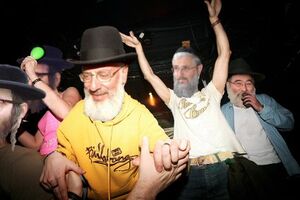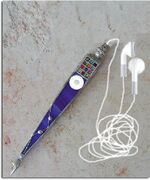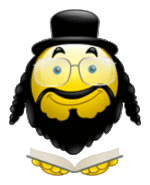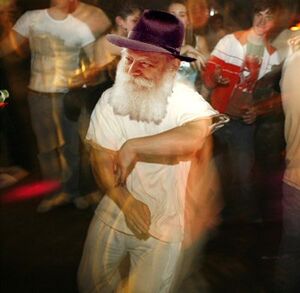Hasid House
“We must take steps to rid ourselves of the Hasid scourge before someone dies.”
“I was standing in the temple, I was searching for my kippah, I had some fresh gefilte, and I needed my tefillin."”
Hasid House is a sub-genre of electronic house music popular at orthodox Jewish rave parties that emphasizes repetitive beats and hypnotic, trance-like melodies. The style's distinctive squelch sounds were developed in the mid 1980s by Chicago rabbis using Roland 303 synthesizers; however, the music was taken to its zenith by British rabbis who DJed at early illegal parties later in that decade.
History[edit]
Chicago Origins[edit]
The Roland 303, along with the same company's 909 drum machine, had been used extensively by a number of bands playing gigs and releasing records locally as part of the Detroit electronica circuit from the mid 80s. However, worries about drug use and over-crowding in non-licensed venues had led to a massive police crackdown, effectively ending the city's notorious synagogue party scene which led a number of hasidic rabbis to relocate to Chicago. Rabbis Nathan "DJ Latke" Lipman, Earl "DJ Shabbos" Steiner and Herbert "Herbale" Jakobitz formed the group Phuture and recorded the 12 minute "Hasid Tracks," credited as being the first true hasid house record in 1986. However, police attention soon led to the demise of the scene, with hasid house selling only a tenth of the records in 1988 that it had at the height of the style's popularity.
London[edit]
Hasid house was first played in London at the exclusive Shul club opened by DJ and rabbi Danny Ramplinski. The club's smoke machines and hallucinogenic light show made it an immediate success with young Jewish party-goers who found the laid-back ambience ideal surroundings in which to take the illegal drug ecstacy, which was becoming enormously popular. Treif, opened by Rabbi Nick Holloberg in 1988, quickly became known for playing a harder form of hasid house known as kosherkore characterised by faster beats and was the first venue to stay open until 3am. Britain's draconian anti-club laws and licensing regulations soon led the police to take an interest. This, combined with drunk Orthodox ravers spilling out into the streets in the early hours while blowing on shofars and loudly reading from the Torah brought calls to close down all hasid house clubs and new regulations were drafted in order to make it more difficult to legally host events of this type. However, the government had underestimated the scene's popularity and the determination of hasid house fans to keep partying - before long, massive hasid house raves were being held in derelict warehouses and rural locations around London's M25 orbital motorway. One such party, Shemeshrise, took place near Reigate in Surrey and is notable for being the largest hasid house rave ever held with an attendance of approximately 20,000.

Media Attention[edit]
“BAN THIS FILTH!”
Like every youth movement in history, hasid house led to moral panic amongst the media. The Sun toilet roll newspaper was the first to report on the hasid craze, originally claiming it to be "cool and groovy" but changed its mind and decided it was evil a few days later - unfortunately, they'd already sold several thousand t-shirts bearing the smiley face used as an emblem by the movement along with the paper's logo which they'd made available at the Super Soaraway Offer Price of just £5.99. The Daily Mail, meanwhile, focused on the foreign origins of the music and claimed that the first hasid house records, imported from overseas, had only entered the UK in order to get low-cost council housing and to make use of "our already cash-strapped NHS." The Daily Express was one of the few newspapers to take no interest, as Princess Diana is not believed to have either owned any hasid house records nor to have ever attended a hasid house rave.
A Typical Hasid House Rave[edit]
“Got any veras?”
Picture a field somewhere in the countryside, on a perfect summer's evening. Birds are singing, and the hum of bees as they collect their last load of pollen (or whatever they collect from flowers) fills the air before they return to the hive and do whatever it is they do with it to make honey - a hypnotic, soothing sound. Suddenly, three or four vans drive into the field from the single-track lane that meanders past the field, a lane that started half a mile away at a B-road and leads to nowhere in particular. The vans park, and several people emerge. At first, with their long hair, unkempt beards and strange clothes, you think they must be hippies; but on closer inspection the big, black hats reveal them to be rabbis. What on earth could a group of rabbis be doing out in a field at this time on a Saturday night, you wonder? Surely they ought to be in the synagogue, watching their nails grow and waiting for the Shabbat to end so they can make a cup of tea. They open the back doors of the vans and begin to take out a number of large speakers, which they connect to an amplifier. Next, two record players are set up. Finally, after much effort, a rather shakey-sounding generator starts up. A new sound joins the pastoral symphony:
DOMPF! DOMPF! DOMPF! DOMPF! DOMPF! DOMPF! DOMPF! DOMPF! DOMPF! DOMPF! DOMPF! DOMPF! DOMPF! DOMPF! DOMPF!
A cheer goes up from the orthodox Jewish kids who have steadily been arriving on foot, by bicycle, by car and clapped out old ambulance since the rabbis got here. Another Saturday night in rural England, and another Hasidic house rave has begun.
Attendance may be anything from a dozen to several hundred. More rabbinical groups may arrive and set up their own musical equipment, known as a sound system, in other corners of the field. Drugs will be taken freely - LSD, ecstacy, ketamine and cannabis are most popular, but cocaine and schmurah matzah flour will also be used. The party will go on at least until the sun comes up, assuming the police haven't arrived by then. Before long, it's possible to see distinct subgroups emerge in the crowd - those taking ecstacy are dancing and singing non-stop like Purim has come early. Those on LSD are arguing over the finer points of Mishnah and Halakha, though they'll take regular breaks to ponder the remarkable handness of their hands or to laugh at particularly amusing leaves and twigs. They may come up with revolutionary new interpretations of the Talmud, but will have forgotten them by the morning.

Hasid House Now[edit]
Hasid house fell out of favour during the early 1990s as the original ravers found themselves in their mid 20s and became the parents of young children with all the responsibilities that such an existence entails, while teenagers rediscovered the guitar and listened to Oasis, Blur and other traditional indie or pop music. However, increasingly politicised Jewish teens, searching for a music to call their own and unsatisfied with the klezmer music listened to by their parents, seized upon the genre and it has undergone a resurgence in popularity in recent years. Hasid house raves became rare for a time, but police estimate around a hundred illegal events now take place in the United Kingdom every weekend during the summer, with more reported by their European counterparts.
This has led to a split amongst fans, with older listeners (who consider themselves purists) labeling young fans sell-outs - accusations fired by the fact that several companies have taken note of the music's regained popularity and see hasid house as just another money-making opportunity. Most notable amongst these are Apple™ Inc., whose online iTunes® store is the source of several million hasid house mp3 downloads each month. Apple™ have also produced a version of their iPod® portable music device designed specifically for the hasid house market, the iYad®, which features a 120 gigabyte hard-disc capable of storing 30,000 tracks.
Notable Recordings[edit]
- Now That's What I Call Hasid (vols. 1 to 947) - various
- Hasid Inferno - All The Hits You Already Have, But In A Different Order - various
- Old Shul Hasid House - various
- Hasid Junkies - various
- Philadelphia Hasid Experiments - Rabbi Nigel Richardski
- Get Hasidic - Rabbi M-D-M


